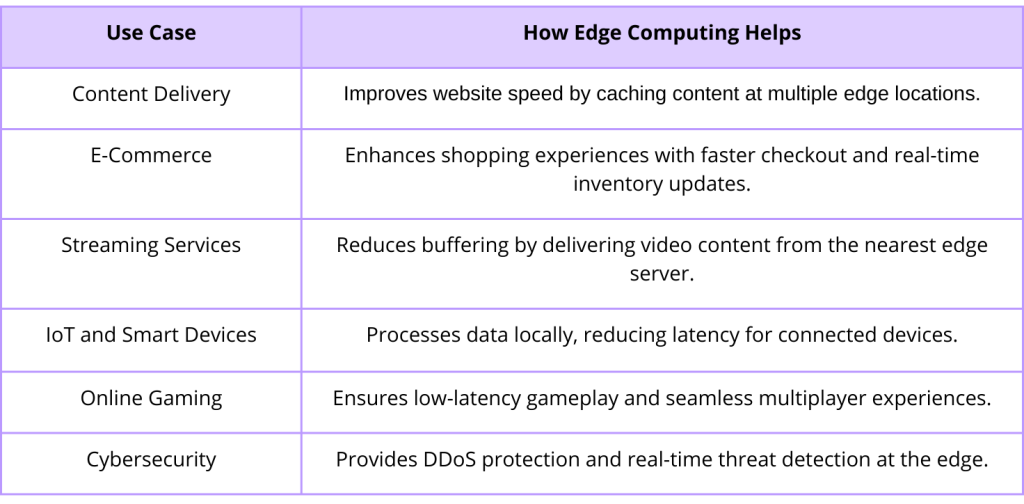
08 Mar How Edge Computing is Changing Web Infrastructure
The increasing demand for faster, more secure, and scalable web applications has led to the rise of edge computing. Traditional cloud computing models rely on centralized data centers, which can cause latency issues and bottlenecks for web applications that require real-time responses. Edge computing addresses these limitations by processing data closer to the end-user, reducing delays and improving performance.
This article explores how edge computing is transforming web infrastructure, its benefits, use cases, and impact on the future of web development.
What is Edge Computing?
Edge computing is a distributed IT architecture that processes data closer to the source rather than relying on a centralized cloud. Instead of sending all requests to a remote data center, edge computing processes critical tasks locally at the “edge” of the network—closer to users and devices.
For example, in a traditional cloud computing model, when a user visits a website, their request travels to a central server, which then processes the request and sends a response back. With edge computing, a nearby edge server can process the request locally, reducing response time and improving efficiency.
How Edge Computing is Transforming Web Infrastructure
1. Faster Load Times and Reduced Latency
Websites and applications must load quickly to retain users. Traditional cloud-based hosting can result in latency due to long-distance data transmission. Edge computing reduces this delay by processing data closer to users, leading to faster page loads and better user experiences.
For example, content delivery networks (CDNs) use edge computing to cache web content on multiple servers worldwide, ensuring users can access websites quickly, regardless of location.
2. Improved Website Security
Cyber threats such as DDoS attacks and data breaches are growing concerns for businesses. Edge security solutions help mitigate these threats by:
- Blocking malicious traffic at the edge, reducing the risk of attacks reaching the core infrastructure.
- Encrypting and filtering data locally, ensuring only secure requests are forwarded.
- Enhancing real-time threat detection, preventing suspicious activities before they impact the system.
3. Optimized Bandwidth Usage
Edge computing reduces bandwidth consumption by processing and filtering data closer to the user. Instead of transmitting large volumes of raw data to central servers, only relevant and processed information is sent, reducing network congestion and operational costs.
This is particularly useful for IoT applications, video streaming, and real-time analytics, where large amounts of data are generated continuously.
4. Greater Scalability for Web Applications
As businesses grow, their web applications must scale efficiently. Edge computing enables seamless horizontal scaling by distributing workloads across multiple edge nodes. This approach prevents server overload and ensures consistent performance even during peak traffic periods.
For example, an e-commerce platform can use edge computing to handle high volumes of traffic during sales events, ensuring fast page loads and smooth checkout processes.
5. Increased Reliability and Uptime
A single point of failure in centralized cloud architecture can cause widespread downtime. By distributing computing resources across multiple edge locations, businesses can ensure that even if one server fails, other edge nodes continue operating, maintaining website uptime.
This redundancy and fault tolerance make edge computing a reliable solution for mission-critical applications.
Key Use Cases of Edge Computing in Web Development

Challenges of Implementing Edge Computing
While edge computing offers significant benefits, businesses must consider the challenges of implementation:
- Infrastructure Costs – Deploying edge servers requires investment in distributed computing resources.
- Data Synchronization – Ensuring consistency between edge and cloud data centers can be complex.
- Security Risks – Managing security across multiple edge locations needs robust encryption and monitoring.
- Technical Expertise – Organizations need IT teams with specialized knowledge of edge computing.
Despite these challenges, the benefits of speed, security, and scalability outweigh the costs for businesses that require high-performance web applications.
How PT KDN Can Help Implement Edge Computing
For businesses looking to integrate edge computing into their web infrastructure, PT. KDN provides:
- Expert consultation on the best edge computing solutions for your needs.
- Scalable edge deployment to enhance website performance and security.
- Ongoing monitoring and management to ensure maximum uptime.
- Cost-effective strategies to reduce cloud expenses while improving efficiency.
By leveraging PT. KDN’s expertise, businesses can stay ahead in the competitive digital landscape and deliver exceptional user experiences.
Conclusion
Edge computing is revolutionizing web infrastructure by reducing latency, improving security, and optimizing bandwidth. As more businesses shift towards real-time applications and scalable solutions, integrating edge computing will be a key competitive advantage.
With faster load times, enhanced security, and greater reliability, edge computing is shaping the future of web development. Businesses that adopt this technology can provide seamless digital experiences while maintaining a cost-effective and secure infrastructure.
For companies looking to implement edge computing strategies, PT. KDN offers tailored solutions to maximize website performance and security.


Sorry, the comment form is closed at this time.